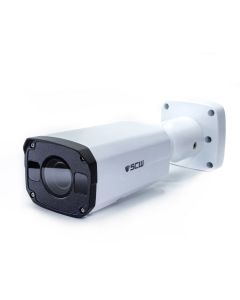Varifocal vs Fixed Lens Security Cameras
What's the difference and when would I need varifocal lenses?
Part 1 - What's the difference?
A fixed lens doesn’t let you adjust the focal length, angle of view, and level of zoom. Almost all fixed lens security cameras have a wide-angle.
With a varifocal camera, you can adjust these things. Let's look at some examples of what this means.
This an image from a fixed lens 4MP camera (The Warrior 4.0), which is fixed at 4mm with someone standing 10 feet away

This is an image from a 4MP Bullet Camera at 12mm (The Viking 4.0, which is adjustable from 2.8 to 12 mm)

By increasing the focal length, you get a much better image of the man/license plate. At ten feet, this doesn't matter very much but at larger distances (which we will show in a second) this can mean the difference between identifying a suspect and not getting a clear enough picture of their face.
There is a drawback to increasing the focal length, however.
By increasing the focal length (the mm setting) and magnifying an area, you reduce your viewing angle, as superimposing the 12mm image on top of the 4mm one easily shows. You get a lot more detail for one area at the cost of losing a wide-angle view.

Not just two settings
A varifocal camera allows you to adjust between its top and bottom limits on its view angle. This means that you have the ability to manually set both the view angle and level of zoom. Have a scenario where you need to zoom in on a gate or other access point? Use the 12mm setting (12 degrees and about 4x zoom). Need a wide-angle view? Go with 2.8 mm (109 degrees). Need something in between? Try 6mm (~45 degrees) or 9mm (~30 degrees).
How to Adjust the Lens
All SCW adjustable cameras feature motorized zoom. This means that you can control the zoom and focus from the camera or NVR--no ladders, no tiny knobs, just simple. easy, and autofocus capable cameras.
Looking to change the viewing angle on the fly when responding to active security threats?
We also have PTZ cameras which allow you to pan, tilt, and zoom via the NVR, computers, or smartphones/tablets.
PTZs also have preset, patrol, and pattern options allowing you to quickly jump to pre-set views.

Part 2 - When Would I Need a Varifocal Lens?
One camera in a square room - When varifocal cameras are nice
Because your normal fixed lens is 75 degrees, placing a fixed lens camera in the corner of a square room, will give you a coverage map like this:

This means that you really need two cameras to cover that area. With one 98 degrees camera, you could cover the whole space and not have to buy two cameras (the walls are 90 degrees). So, a varifocal camera, set at 98 degrees would be able to see the whole room.
Distance - When varifocal cameras become necessary
At about 50-100 foot a wide-angle lens 1080P camera will not do a tremendously good job at identifying faces. At about twenty feet a standard definition camera will also not work to identify faces, but if you are willing to pay for a varifocal standard definition camera you should go HD wide-angle. For about the same price as a standard definition varifocal, you get a higher resolution picture that extends the distance that you can identify faces while not giving up any of the wide-angle view.
To demonstrate why varifocal cameras are necessary at distance, here's a picture of the same man throwing a rock with the same 1080P fixed lens camera (The Warrior), this time from 50 feet

And now from 100 feet

With greater distances, a wide-angle view camera will lack the ability to identify faces. It becomes necessary to use a higher millimeter lens when you are trying to identify a security threat that is further away.
Here are the same two scenarios with the Viking set at 12mm


Practical Applications: When you should absolutely use a Varifocal Camera
1. When you only have the budget to have one camera in a room, only need one, and the room has 90-degree walls.
2. When you have a gate, door, or other known entrance point but can't mount a camera very close.
3. When it is imperative that you get a close shot to identify a person or vehicle and have a good idea where they are going to be.
4. Anytime you want to identify someone more than 50 ft away.

Lean on the experts
We'd be happy to work up a custom quote or take your floorplan and create a security coverage map.
Get a Custom Quote













